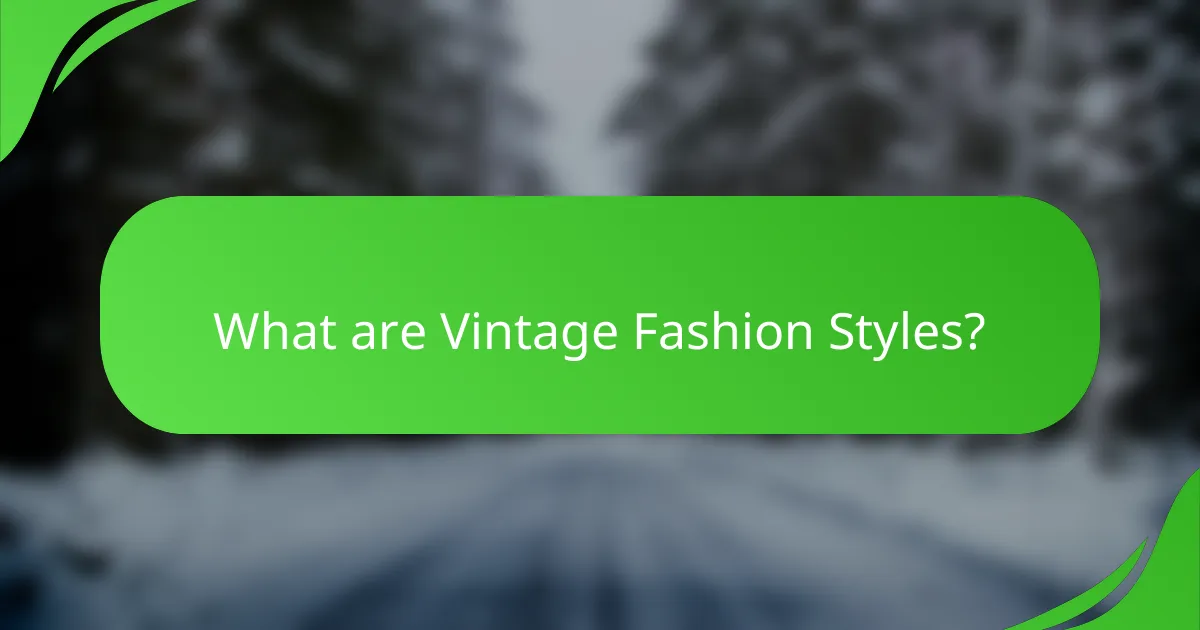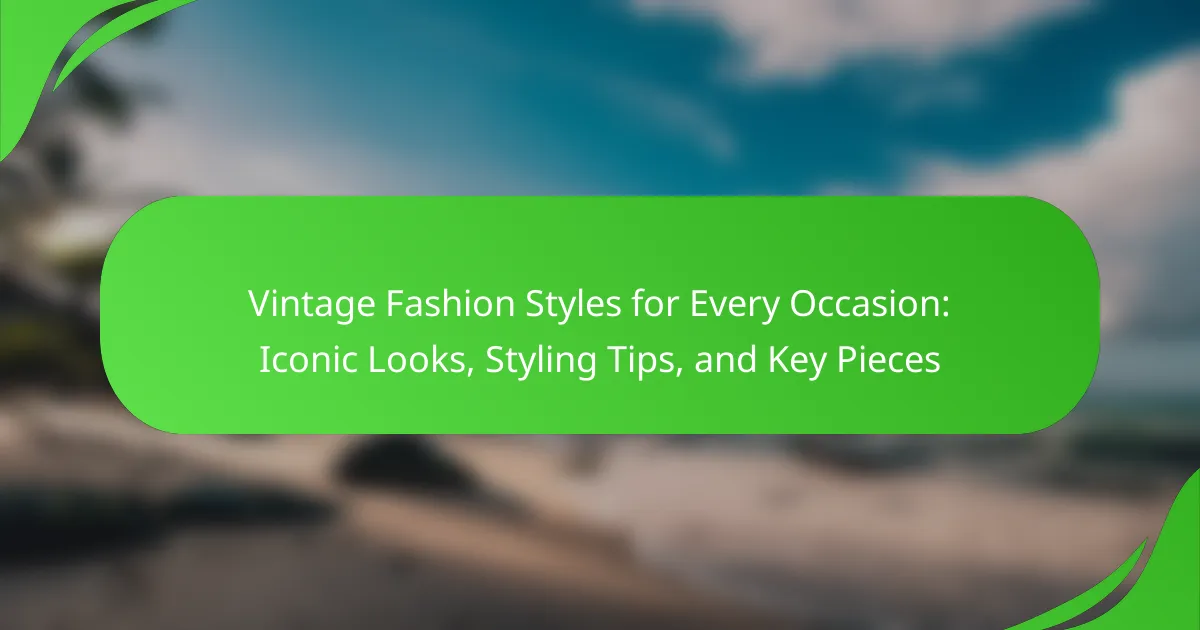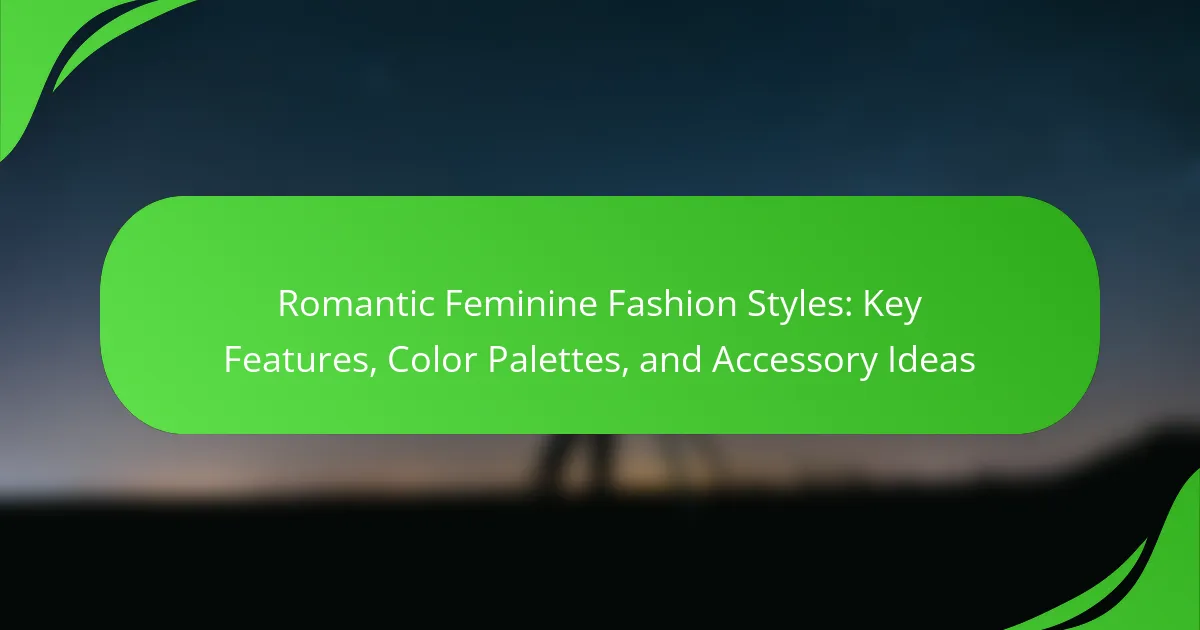Vintage fashion styles encompass clothing and accessories that reflect the aesthetics and cultural trends of past decades, specifically from the 1920s to the 1990s. This article explores iconic vintage styles suitable for various occasions, including the flapper dress for parties, the 1940s tea dress for casual events, and the 1950s swing dress for formal gatherings. It also provides practical styling tips, emphasizing the importance of key pieces such as high-waisted jeans and tailored blazers, as well as the effective use of accessories and footwear to create balanced vintage looks. Each style is examined for its historical significance and relevance in contemporary fashion, highlighting the craftsmanship and uniqueness that vintage clothing offers.

What are Vintage Fashion Styles?
Vintage fashion styles refer to clothing and accessories that are characteristic of specific past decades, typically from the 1920s to the 1990s. These styles often reflect cultural trends, social movements, and aesthetic preferences of their respective eras. For example, the flapper dresses of the 1920s symbolize the liberation of women. The 1950s featured classic silhouettes like swing dresses and tailored suits, which highlight post-war optimism. The bohemian looks of the 1960s and 1970s embraced free-spirited individuality. Vintage fashion is celebrated for its unique designs and craftsmanship, often standing in contrast to contemporary mass-produced clothing. Collectors and enthusiasts value these styles for their nostalgia and historical significance.
How did Vintage Fashion evolve over the decades?
Vintage fashion evolved significantly from the 1920s to the 1990s. In the 1920s, flapper dresses symbolized women’s liberation. The 1930s introduced more elegant silhouettes, influenced by Hollywood glamour. The 1940s saw practical styles due to wartime restrictions, with tailored suits and utility dresses. In the 1950s, fashion emphasized femininity with full skirts and fitted bodices, epitomized by Dior’s “New Look.” The 1960s embraced youth culture and bold patterns, with mini skirts and mod styles gaining popularity. The 1970s brought bohemian and disco influences, showcasing diverse styles. The 1980s focused on power dressing with oversized silhouettes and vibrant colors. By the 1990s, vintage fashion became a nostalgic reference, blending elements from previous decades. Each decade’s fashion reflected societal changes and cultural movements, shaping the evolution of vintage fashion.
What are the defining characteristics of Vintage Fashion from different eras?
Vintage fashion is characterized by distinct styles and trends from specific historical periods. Each era has unique attributes that define its fashion. The 1920s featured flapper dresses, bobbed hair, and cloche hats, emphasizing a sense of liberation. The 1930s introduced elegant silhouettes, bias-cut gowns, and Hollywood glamour, reflecting the influence of cinema. The 1940s showcased wartime practicality with utility clothing, shoulder pads, and A-line skirts. The 1950s celebrated femininity with full skirts, fitted bodices, and pastel colors, exemplified by designers like Dior. The 1960s embraced bold patterns, mini skirts, and youth culture, influenced by icons like Twiggy. The 1970s marked a shift to bohemian styles, bell-bottoms, and vibrant prints, reflecting counterculture movements. Each era’s fashion is rooted in social and cultural changes, making vintage clothing a reflection of its time.
How do cultural influences shape Vintage Fashion trends?
Cultural influences significantly shape Vintage Fashion trends by reflecting societal values and historical events. Styles from various decades often resurface due to nostalgia and cultural revival. For instance, the 1920s flapper dresses symbolize women’s liberation post-World War I. Similarly, the 1960s mod fashion reflects the youth counterculture and social change. Fashion designers frequently draw inspiration from art movements, music, and film, incorporating elements that resonate with contemporary audiences. The blend of ethnic patterns and styles also showcases cultural diversity in vintage fashion. Events like fashion weeks often highlight these influences, showcasing retro styles with modern twists. Thus, cultural contexts play a crucial role in the evolution of vintage fashion trends.
Why is Vintage Fashion popular today?
Vintage fashion is popular today due to its unique aesthetic and sustainable appeal. Many consumers seek individuality in their clothing choices, which vintage items provide. The resurgence of vintage trends is also linked to a growing awareness of environmental issues. Shopping for vintage reduces waste and promotes recycling. Additionally, social media platforms showcase vintage styles, influencing fashion trends. Events like thrift store pop-ups and vintage fairs have increased accessibility. According to a 2020 survey by ThredUp, 70% of consumers are interested in secondhand shopping. This interest reflects a shift towards mindful consumption in fashion.
What are the key benefits of incorporating Vintage Fashion into modern wardrobes?
Incorporating vintage fashion into modern wardrobes offers unique benefits. One key benefit is individuality. Vintage pieces allow for personal expression, setting wearers apart from mainstream trends. Another benefit is sustainability. Choosing vintage reduces waste and promotes eco-friendly fashion practices. Additionally, vintage fashion often showcases superior craftsmanship. Many vintage items were made with higher quality materials and techniques. This results in durability and longevity, making them worthwhile investments. Furthermore, vintage fashion can provide historical context. Wearing vintage connects individuals to past styles and cultural movements. Lastly, vintage items often have a timeless appeal. They can enhance modern outfits with a touch of nostalgia and character.
How does Vintage Fashion promote sustainability in the clothing industry?
Vintage fashion promotes sustainability in the clothing industry by encouraging the reuse of garments. This practice reduces waste and minimizes the demand for new clothing production. By choosing vintage items, consumers support a circular economy. Vintage clothing often utilizes high-quality materials, leading to longer-lasting products. According to a study by the Ellen MacArthur Foundation, extending the life of garments by just nine months can reduce carbon, water, and waste footprints by 20-30%. Additionally, vintage fashion helps preserve cultural heritage and unique styles. This not only promotes sustainability but also fosters individuality in fashion choices.
![]()
What are the iconic Vintage Fashion styles for various occasions?
Iconic vintage fashion styles for various occasions include the flapper dress for parties, the 1940s tea dress for casual events, and the 1950s swing dress for formal gatherings. The flapper dress, characterized by its loose fit and fringe details, symbolizes the Roaring Twenties. It is often worn at cocktail parties and jazz events. The 1940s tea dress features a fitted bodice and a flared skirt, suitable for afternoon tea or casual outings. The 1950s swing dress, known for its voluminous skirt and cinched waist, is perfect for weddings and formal occasions. Each style reflects its era’s cultural influences and remains relevant in contemporary fashion.
What are some classic Vintage looks for formal events?
Classic vintage looks for formal events include the 1920s flapper dress, the 1950s tea-length gown, and the 1940s Hollywood glamour style. The 1920s flapper dress features fringe, beading, and a dropped waist, reflecting the Jazz Age’s exuberance. The 1950s tea-length gown is characterized by a fitted bodice and full skirt, often made from tulle or satin. The 1940s Hollywood glamour style emphasizes elegant silhouettes, bold colors, and luxurious fabrics, often seen in floor-length gowns. These styles have remained timeless and are often chosen for their elegance and historical significance in fashion.
How can one style a Vintage dress for a wedding?
To style a vintage dress for a wedding, choose accessories that complement the dress’s era. For a 1920s flapper dress, opt for long pearl necklaces and feathered headbands. A 1950s swing dress pairs well with a fitted cardigan and classic pumps. Select a vintage-inspired clutch to enhance the overall look. Incorporate modern elements, like contemporary jewelry, to balance the vintage vibe. Ensure the color palette matches the wedding theme for cohesion. Vintage dresses often feature unique prints or textures, so let them stand out. Finally, consider the wedding’s formality to guide your styling choices.
What accessories complement formal Vintage outfits?
Classic accessories that complement formal Vintage outfits include pearl necklaces, vintage brooches, and elegant gloves. Pearl necklaces add a timeless elegance, often seen in the 1920s and 1950s fashion. Vintage brooches serve as unique statement pieces, reflecting personal style and historical significance. Elegant gloves enhance the sophistication of formal attire, commonly worn during the mid-20th century. Additionally, vintage handbags, especially clutches, provide a refined finishing touch. Fascinators or vintage hats can elevate the overall look, reminiscent of styles from the 1940s and 1950s. These accessories not only enhance the outfit but also connect to the rich history of Vintage fashion.
What are the best Vintage styles for casual outings?
The best vintage styles for casual outings include the 1950s swing dress, 1970s bohemian maxi dresses, and 1960s mod outfits. The 1950s swing dress offers a flattering silhouette and is often made from cotton or linen. This style is perfect for warm weather and casual gatherings.
The 1970s bohemian maxi dress features flowing fabrics and vibrant patterns. It provides comfort and a laid-back vibe, ideal for outdoor events.
The 1960s mod outfits, characterized by bold colors and geometric patterns, are stylish and easy to wear. These pieces often include A-line skirts and fitted tops, making them suitable for casual outings.
Each of these styles reflects the essence of vintage fashion while providing comfort and versatility for everyday wear.
How can Vintage denim be styled for everyday wear?
Vintage denim can be styled for everyday wear by pairing it with simple, modern pieces. For example, a vintage denim jacket works well with a plain white t-shirt and black skinny jeans. This combination balances the retro aesthetic with contemporary style. Vintage high-waisted jeans can be matched with a tucked-in blouse for a polished look. Footwear options include classic sneakers or ankle boots to enhance comfort. Accessories like minimalistic jewelry or a crossbody bag can complete the outfit. Layering with a fitted turtleneck under a vintage denim jacket adds warmth and style. Additionally, incorporating a vintage denim skirt with a casual sweater creates a relaxed vibe. These styling choices reflect the versatility of vintage denim in everyday settings.
What are some key pieces for a Vintage-inspired casual wardrobe?
Key pieces for a Vintage-inspired casual wardrobe include high-waisted jeans, graphic tees, and oversized cardigans. High-waisted jeans are reminiscent of styles from the 70s and flatter various body types. Graphic tees often feature retro designs or logos, adding a playful element. Oversized cardigans provide warmth and comfort while showcasing a relaxed silhouette. Vintage-inspired sneakers or loafers complete the look, offering both style and practicality. Accessories like cat-eye sunglasses and headscarves enhance the vintage aesthetic, making the outfit more cohesive. These elements combine to create a versatile and stylish vintage-inspired casual wardrobe.

How can you effectively style Vintage Fashion?
To effectively style Vintage Fashion, choose key pieces that reflect the era you want to represent. Incorporate classic items like high-waisted jeans, A-line dresses, or tailored blazers. Layering is essential; mix vintage with modern elements for balance. Accessories such as statement jewelry or retro handbags enhance the look. Footwear plays a critical role; opt for vintage-inspired shoes like Mary Janes or loafers. Pay attention to color palettes; muted tones often evoke a vintage feel. Lastly, consider the occasion; casual looks can be achieved with denim, while formal events may require more elegant vintage attire.
What are essential tips for mixing Vintage and modern pieces?
To successfully mix vintage and modern pieces, focus on balance and cohesion. Start by choosing a color palette that harmonizes both styles. This creates a unified look. Incorporate one statement vintage piece into your outfit. This draws attention without overwhelming the modern elements. Layering is effective; pair a vintage blazer with contemporary jeans. This combination adds depth to your attire. Accessorize wisely; modern accessories can elevate vintage garments. Consider textures; mixing different fabrics can enhance visual interest. Finally, maintain your personal style throughout the ensemble. This ensures authenticity in your fashion choices.
How can color coordination enhance a Vintage outfit?
Color coordination can significantly enhance a Vintage outfit by creating a cohesive and harmonious look. When colors complement each other, they draw attention to the outfit’s unique features. This enhances the overall aesthetic, making the ensemble visually appealing. For instance, pairing pastel shades can evoke a soft, retro vibe typical of the 1950s. In contrast, bold colors can reflect the vibrant styles of the 1980s. Additionally, understanding color theory can guide choices that highlight the outfit’s era. For example, using analogous colors can create a subtle yet sophisticated appearance. Effective color coordination also helps in accessorizing, ensuring that shoes, bags, and jewelry align with the outfit’s palette. Ultimately, thoughtful color choices can elevate a Vintage outfit, making it stand out and resonate with the intended style.
What role do textures play in styling Vintage Fashion?
Textures play a crucial role in styling Vintage Fashion. They enhance the visual appeal and authenticity of vintage outfits. Different textures can evoke specific eras and styles. For example, silk adds elegance, while denim brings a casual vibe. Mixing textures creates depth and interest in an outfit. Layering various fabrics can highlight unique vintage pieces. Textures also influence the overall comfort and fit of clothing. Historical context shows that textures were often used to signify social status or fashion trends.
What key pieces should every Vintage Fashion enthusiast have?
Every Vintage Fashion enthusiast should have a collection of essential pieces. Key items include a classic little black dress, which has been a staple since the 1920s. Vintage denim jackets are also crucial, popularized in the 1950s. A pair of high-waisted trousers can add a retro flair, reminiscent of the 1940s. Additionally, a vintage handbag completes the look, with styles dating back to the 1960s. Accessories like statement jewelry from the 1980s enhance any outfit. Lastly, a pair of retro sunglasses, which gained popularity in the 1970s, is a must-have. These pieces not only reflect the history of fashion but also allow for versatile styling options.
Which Vintage accessories are must-haves for completing a look?
Vintage accessories that are must-haves for completing a look include statement jewelry, vintage handbags, and classic hats. Statement jewelry, such as brooches or oversized earrings, adds a focal point to outfits. Vintage handbags, especially structured designs, enhance the overall aesthetic. Classic hats, like fedoras or cloches, can elevate any vintage ensemble. Scarves, particularly silk ones, offer versatility in styling. Additionally, vintage sunglasses provide a chic touch while protecting the eyes. Each of these accessories has been historically significant in fashion, making them essential for authentic vintage looks.
How can one identify quality Vintage clothing when shopping?
To identify quality vintage clothing when shopping, examine the fabric and stitching. High-quality vintage pieces often use natural fibers like wool, silk, or cotton. Check for even stitching and reinforced seams, which indicate durability. Look for labels that reflect reputable brands or designers known for quality craftsmanship. Inspect the garment for signs of wear; minimal wear suggests better quality. Evaluate the fit; vintage clothing should drape well and complement the body. Research specific eras for style and fabric trends to better understand quality indicators. These factors combined help ensure the purchase of authentic, high-quality vintage clothing.
What practical tips can help you embrace Vintage Fashion?
To embrace Vintage Fashion, start by researching specific eras that inspire you. Focus on the 1920s to 1970s for a diverse range of styles. Visit thrift stores and vintage shops to find authentic pieces. Look for quality fabrics and unique designs that stand out. Incorporate vintage accessories like hats, jewelry, and bags to elevate your outfit. Mix vintage items with modern pieces for a balanced look. Attend vintage fairs or markets to discover rare finds. Lastly, consider learning basic sewing skills to tailor vintage clothes for a perfect fit.
How can you maintain and care for Vintage garments?
To maintain and care for vintage garments, handle them gently and store them properly. Use padded hangers to avoid stretching and maintain shape. Keep garments in a cool, dry place away from direct sunlight to prevent fading and deterioration. Clean vintage clothing using mild detergents and cold water to avoid damage. Always test a small area first when using any cleaning method. If necessary, seek professional cleaning services specializing in vintage items. Regularly inspect garments for signs of wear or damage to address issues promptly. Proper care can extend the life of vintage clothing significantly.
What are some common styling mistakes to avoid with Vintage Fashion?
Common styling mistakes to avoid with vintage fashion include mismatching eras. Each vintage piece has a specific style context. Mixing items from different decades can create a disjointed look. Another mistake is neglecting proper fit. Vintage clothing often has unique sizing, so tailoring may be necessary. Over-accessorizing is also a common error. Too many accessories can overwhelm the vintage aesthetic. Additionally, ignoring fabric care can damage vintage pieces. Proper cleaning and storage are essential for preservation. Lastly, failing to balance vintage with modern items can lead to an outdated appearance. A mix of both can create a fresh, contemporary look.
Vintage fashion styles encompass clothing and accessories from past decades, specifically from the 1920s to the 1990s, reflecting cultural trends and social movements. The article covers the evolution of vintage fashion across these decades, highlighting defining characteristics, cultural influences, and the reasons for its current popularity. It also provides practical styling tips for various occasions, including formal events and casual outings, along with advice on incorporating vintage pieces into modern wardrobes. Key benefits of vintage fashion, such as sustainability and individuality, are discussed, alongside essential tips for maintaining and identifying quality vintage garments.


